


SITE LOGIN
- REVIEWS
- NEWS
- STORE
- ROUTES
- LODGING
-
VIDEOS
- 2022/23 Gear Reviews
- 2021/22 Gear Reviews
- 2020/21 Gear Reviews
- 2019/20 Gear Reviews
- 2018/19 Gear Reviews
- 2017/18 Gear Reviews
- 2016/17 Gear Reviews
- 2015/16 Gear Reviews
- 2014/15 Gear Reviews
- 2013/14 Gear Reviews
- 2012/13 Gear Reviews
- 2011/12 Gear Reviews
- 2020 Outdoor Retailer
- 2019 Outdoor Retailer
- 2018 Outdoor Retailer
- 2017 Outdoor Presscamp
- 2017 Outdoor Retailer
- 2016 Outdoor Presscamp
- 2016 Outdoor Retailer
- 2015 SIA Show
- 2014 Outdoor Retailer
- 2013 SIA Show
- 2012 Outdoor Retailer
- Tips and Tricks
- Backcountry Skiing
- SAFETY
- ABOUT
- REVIEWS
- NEWS
- STORE
- ROUTES
- LODGING
-
VIDEOS
- 2022/23 Gear Reviews
- 2021/22 Gear Reviews
- 2020/21 Gear Reviews
- 2019/20 Gear Reviews
- 2018/19 Gear Reviews
- 2017/18 Gear Reviews
- 2016/17 Gear Reviews
- 2015/16 Gear Reviews
- 2014/15 Gear Reviews
- 2013/14 Gear Reviews
- 2012/13 Gear Reviews
- 2011/12 Gear Reviews
- 2020 Outdoor Retailer
- 2019 Outdoor Retailer
- 2018 Outdoor Retailer
- 2017 Outdoor Presscamp
- 2017 Outdoor Retailer
- 2016 Outdoor Presscamp
- 2016 Outdoor Retailer
- 2015 SIA Show
- 2014 Outdoor Retailer
- 2013 SIA Show
- 2012 Outdoor Retailer
- Tips and Tricks
- Backcountry Skiing
- SAFETY
- ABOUT
TOP VIDEOS
Marker Alpinist 12 Bindings
Marker is no stranger to the alpine touring binding market with such successes as the Marker F10, Marker F12 and Maker Kinpin binding. While all of these bindings are fairly lightweight when compared to tech bindings, only the Kingpin can be considered a semi-tech binding but its alpine heel still makes it a heavyweight contender. With the runaway growth of backcountry skiing, the demand for lightweight tech bindings has increased and alpine touring frame bindings have become less popular. It was therefore only a matter of time before Marker used it’s decades of know-how and experience in the market place to create a light-weight full tech touring binding. Last winter Marker released their Alpinist 9 and 12 bindings in Courmayeur Italy and we were there to get the inside scoop. This winter we’ve been testing a pair of the Marker Alpinist 12 binding and the following review sums up our thoughts.
Watch below for an overview of the Marker Alpinist 12 Bindings:
- SHOW THE REST OF THE REVIEW / PHOTOS / VIDEOS
-
The Alpinist comes in two flavours, the Alpinist 9 and the Alpinist 12; this review will focus on the later. The Alpinist 9 has a DIN of 4-9 whereas the Alpinist 12 has a DIN of 6-12. other than the different release values of the U-springs used both bindings are essentially identical. A “Long Travel” version with 30 mm of boot length adjustment will be available for both the Alpinist 9 and 12, whereas the regular versions provide only 15 mm of boot length adjustment. If you are a skier that uses multiple boots with varying sole lengths or are looking at a binding for many users such as in a rental scenario then consider the Long Travel versions of the Alpinist.
Marker’s claimed DIN setting for the Alpinist is for lateral release only, the U-spring controls the vertical release and is fixed. Marker offers three alternatives to the stock U-spring that comes with each binding, these are Soft (DIN 5), Medium (DIN 7.5) and Hard (DIN 10.5). These springs can easily be swapped out with an Allen Key at the back of the binding’s heel unit.
Marker’s head of Research & Development talks about the new Alpinist Binding in this video:
Marker strived to facilitate stepping into the Alpinist as easily as possible and decided to do so without the use of bumpers on the toe unit. Instead, they optimized the distance of the pins to be just right for the average AT boot and ensured the clamping jaws to shut with authority so that they would self-centre on the tech fittings in your boots. The double springs in the toe, combined with a higher pivot point of 3° for the arms, creating a much stronger closure force than most tech bindings. Keeping the heel of your boot low and level with the ski helps improve accuracy, and stepping in time and time again should be fairly easy
Toe piece in lockout mode and ready to shred.The heel unit on the Alpinist has 4mm of dynamic length compensation so the back of your boots actually kiss the front of the Alpinist heel units. This 4mm tolerance helps to increase the consistency of any release and improves the connection between boot and ski. There is also 15mm of linear adjustment so you can swap out boots with different sole lengths if required. With a neutral ramp angle the Alpinists are easy to walk in on flat ground and with three riser positions (including flat) you’ll have a few options when climbing. Removable brakes round things out and also add 90g to the binding’s base weight of 245g (per binding). Brakes are available in 90, 105, and 115mm widths and are optional but installing them after mounting the Alpinists entails removing the entire heel unit. In order to retract the brakes for ski mode you need to push down on the brake’s anti friction platform first and then push in the wire bail at the rear of the heel piece. Pulling the bail out towards the back of the ski disengages the brake.
For uphill travel, the 5° riser is easy to activate with a pole without having to rotate the heel of the binding. The riser simply flips forward and covers the tech pins and you’re ready to walk. Should you want a 0° or the ‘high heels’ setting of 9° then you will have to manually rotate the heel piece with your hand, sorry no short cuts here.Check out how the Marker Alpinist Binding works in Courmayeur Italy at its unveiling:Materials:
Forged aluminium, carbon fibre-reinforced polyamide
Features:
- Dynamic Length Compensation in the heel piece eliminates ski flex from the release value equation.
- 15mm of boot sole adjustment in the heel so you can use multiple boots.
- Adjustable lateral release from 6-12.
- U-Spring controls vertical release and is swappable with Low and Medium springs, available separately.
- Wide 38mm hole pattern in the toe piece means more ski-hold and power transfer.
- Rubber stops on the toe piece aid step-in.
- Riser levels of 0°, 5° and 9° (0° an 9° require heel piece to be rotated).
- Optional brakes come in 90mm, 105mm, and 115mm sizes.
- Available Pintech ski crampons fit snugly in the receptors.
Verdict:
I applaud Marker for joining the tech binding revolution, their Alpinist 12 is a solid entry and compliments their Kingpin and ageing F10 and 12 bindings. Overall, the Alpinists feel very secure and solid which is surprising due to the lack of metal in their construction. Marker has used a carbon reinforced plastic for both the toe and heel’s chassis trims some of the weight and enabling the Alpinist to be a true climbing binding. The Alpinists transfer power to the ski quite effectively and helped to dampen excessive vibrations and smooth things out when compared to other light tech bindings. I think the amount of carbon fibre-reinforced polyamide used in the Alpinist’s instead of aluminum is the reason for this.
The Alpinist’s most aggressive riser provides an increased ramp angle of just 9° which some may feel is not enough. This is a fair criticism as 9° is about the same angle as the middle riser on the Hagan Core 12 and Salomon MTN bindings. However, if you need more than 9° your skin track is perhaps simply too steep to begin with, I’m sure most Europeans would agree. In my testing I found that I would use the flat and 9° riser exclusively and forego the 5° setting and while this entails turning the heel to access these setting, I didn’t mind and just got in the habit of doing this at each and every transition.
One downside of tech bindings that use U-springs is that they prematurely wear out the pin inserts in touring boots and therefore change the release characteristics over time. This process takes significant time and the weight savings achieved with a U-spring design is pretty advantageous. As well the U-spring and tech fittings in your boots can easily be replaced and are relatively inexpensive. Going über light does have it’s downside but it’s minimal.
While I’m a huge fan of the Alpinist binding design, the optional brakes are definitely their Achilles' heel. The brake’s integration appears to be a bit of an after-thought, not only do the brake arms provide minimal stopping power due to their length but engaging and storing the brakes entail using a very small wire bail that is hard to operate with gloves on and is in danger of icing up. To retract the brakes, you’ll need to first push them down into place and then push in the wire bail at the rear of the heel piece. Pulling the bail out towards the back of the ski disengages the brake. While this process works, it’s not very elegant for such a high end AT binding.
The only other note of concern is the minimal gap between your boots and the heel piece of the Alpinist. While not an issue in most circumstances, you may encounter friction when stepping into the Alpinist if the ski is flexed a minor amount, something to take note of.
The lateral release of the Alpinist is adjustable, however, the vertical release is provided solely by the U-shaped spring. If safety is of primary concern and you want to be able to control both the vertical and lateral release values then you may want to look at the Hagan Core 12 binding but you’ll be incurring a weight and financial penalty for this ability.
One of the biggest benefits of the Alpinist 12 over all the other competitors has to be the significantly cheaper price point. Competing tech bindings such as the Hagan Core Binding cost an additional $345 while the Black Diamond Helio 200’s $200 more expensive.
Overall, the Marker Alpinist 12 is a lightweight, feature-rich, touring binding that provides good value along with confidence-inspiring skiing and easy climbing, poor brake design aside, this is a serious tech binding that demands your consideration.
 |
PROS:
|
 |
CONS:
|
SPECS:
Price: $499.99 CAN / $395US
Weight: 335g / 245g w/o brake (per binding)
DIN release value: 6-12
Brake widths: 90, 105, 115 mm
Crampon widths: 80, 90, 105, 120 mm
Climbing aids: Flat, 31, 40 mm or 0°, 5°, 9°
Boot sole length adjustment: 15 mm
Forward elastic travel: 4 mm
Colours: Black/titanium, Black/Red
RATING: 8.5/10
Transition 1/2
Durability 2/2
Weight 2/2
Quality / Price 2/2
Did we miss something? Are we totally out to lunch? Let us know what you think. People like/dislike gear for different reasons so chime in below and we'll get a well-rounded evaluation. You'll need to login or register before you can comment but it only takes a few seconds, then you're good to go.
Leave a Comment:
Copyright © 2009-25 Backcountry Skiing Canada. All Rights Reserved.
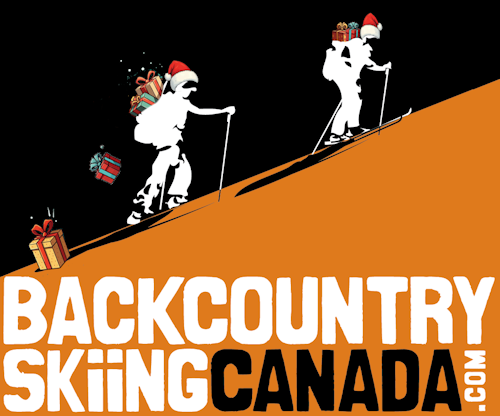

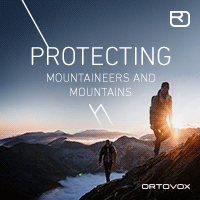
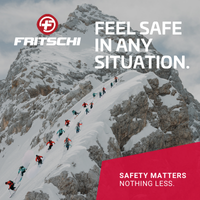

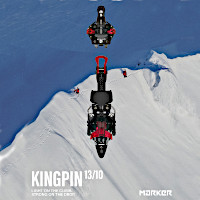
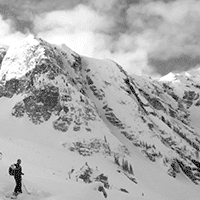
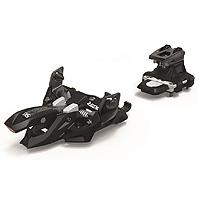
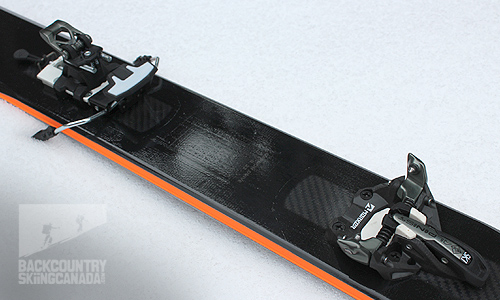
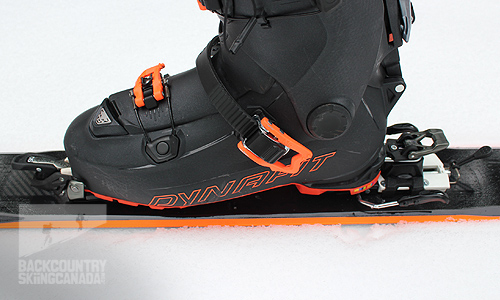
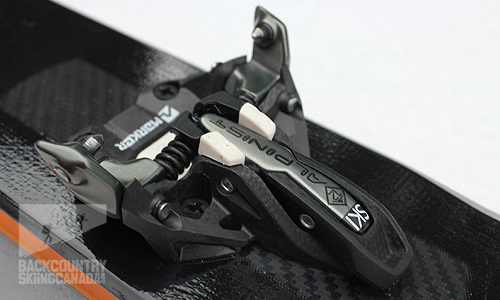
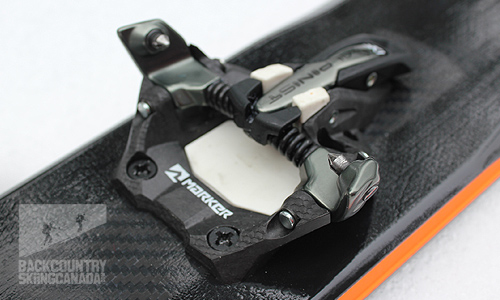
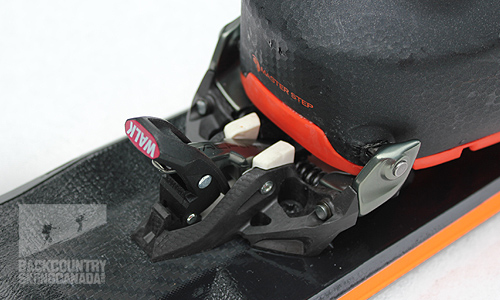
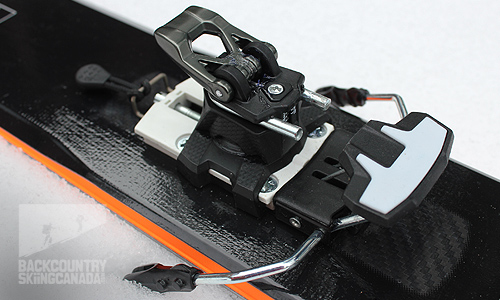
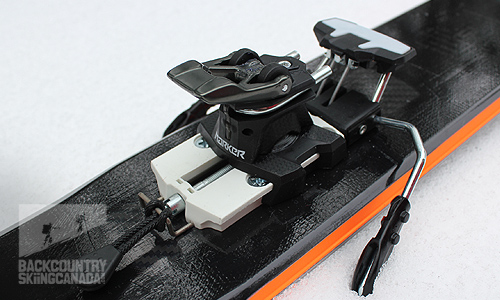
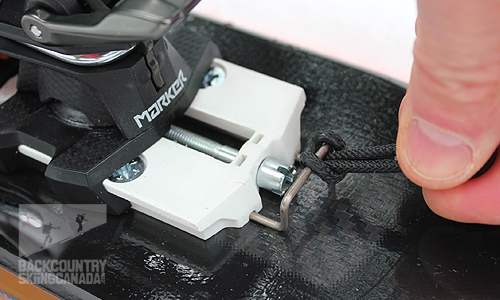
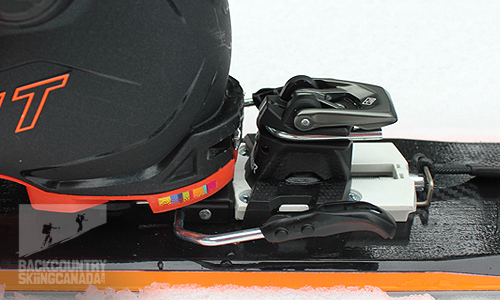
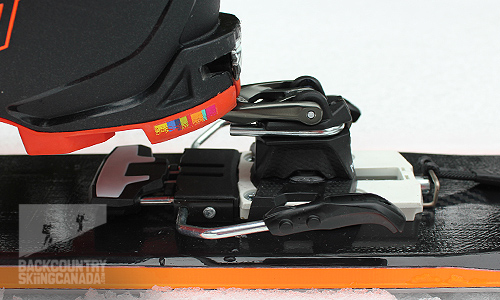
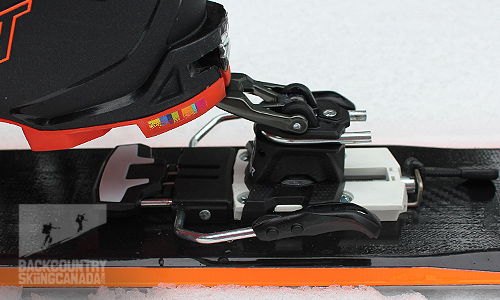
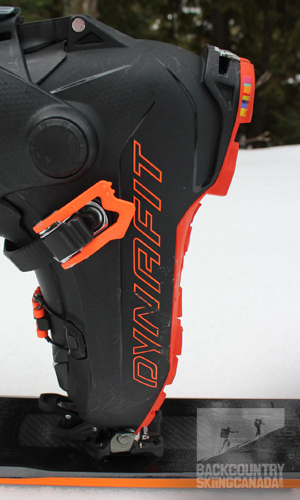

I recently had two guests with these bindings. I can't recommend them for the following reasons:
Ken - Elevation Guides
I am still a fan of the Alpinist due to their lightweight and simple design, if they can improve the brake mechanism then I would be totally happy, not that it doesn't work, it does, but it just seems as you said like it may not stand up to a lot of abuse. So far mine have and continue to perform well.
Yeah, I thought the same thing with the heel sliding, but verified the toe piece was totally locked. I only noticed this on the second set of bindings. I wasn't aware of it with the first guest, she may have had this as well but I didn't know to check.
The snow build-up happens mainly in deep snow, high humidity snow conditions. Like the kind we have in JaPow. I've seen this same thing with Kingpins over the years. It's a simple fix, Marker just needs to increase the spacing under the toe piece like nearly every other tech binding including Dynafit has done.
Cheers.